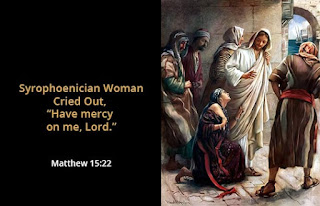LIVES OF THE PATRIARCHS #227 | THE LIFE OF MOSES #208
Pastor Christopher Choo
Lesson 3913
LIVES OF THE PATRIARCHS #227
THE LIFE OF MOSES #208
MOSES AT MT.SINAI#107
THE TABERNACLE OF MOSES ( Part 66)
THE TABLE OF SHOWBREAD IN THE TABERNACLE OF MOSES #20
WHAT IS THE SIGNIFICANCE OF THE CHILDREN'S BREAD?
To avoid crowds and religious leaders for a while, Jesus went to the Gentile district of Tyre and Sidon. He is likely exhausted at this point in His ministry (Matthew 13:1–2; 14:13–14, 34–36).
Somehow, a believing Canaanite woman has found Him here. She is not Jewish, but she likely believes He is the Messiah and that He can cast a demon from her daughter (Matthew 15:21–23).
Jesus has refused because His designated mission—for now—is only to Israelites (Matthew 15:26).
What Jesus says in this verse is often torn from that context, and the words which follow, to make it seem derogatory, or even hateful. It's neither: Jesus has a purpose for this dialogue (Matthew 15:28).
However, these words would have been difficult for the woman to hear, regardless. Christ's intent, apparently, is to test the woman's commitment to her request, and her faith in Him.
Jewish people sometimes called Gentiles "dogs" to show their disrespect for them. Dogs in the ancient middle east were most often seen running in packs, as dangerous scavengers.
Jewish people would not, in general, think of them as either pets or friendly creatures.
However, the word Jesus uses is not as harsh as it sounds when translated into English. The Greek term He uses, Kynariois, literally means "little dog." In the context of children and food, this seems to be a reference to a pet; this would have been a more common use of dogs in a Gentile region.
There's no question that Jesus' symbolism here depicts Israelites as God's children and this woman—or her child—as a "little dog;" not even as a person.
However, Jesus is not trying to be hurtful. He is comparing the nature of God's relationship with His chosen people Israel to those in the rest of the world who practice pagan idolatry.
He says this to prove the woman's humility and faith, knowing He will shortly reward both.
He tells the woman His mission is only to Israel, using a metaphor about table scraps. The woman persists, and Jesus praises her for her for faith. Her daughter is healed instantly.
Healing is in Christ’s atonement. Look at what it says here in 1 Peter, talking about Jesus:
"Who his own self bare our sins in his own body on the tree, that we, being dead to sins, should live unto righteousness: by whose stripes ye were healed."
1 Peter 2:24
Notice how it says Jesus took stripes for your healing! It’s yours! It’s one of the things Jesus bought for you through His sacrifice! And this verse says, “Ye were healed” (emphasis mine)—past tense.
It’s taken from a prophecy Isaiah gave in Isaiah 53, which says,
"But he was wounded for our transgressions, he was bruised for our iniquities: the chastisement of our peace was upon him; and with his stripes we are healed."
Isaiah 53:5
Some people try to make this mean Jesus only took stripes for our spiritual healing. Well, he did suffer for our spiritual health, but let’s look at how the prophecy was fulfilled, in Matthew 8:
"When the even was come, they brought unto him many that were possessed with devils: and he cast out the spirits with his word, and healed all that were sick: [17] That it might be fulfilled which was spoken by Esaias [Isaiah] the prophet, saying, Himself took our infirmities, and bare our sicknesses."
(Matthew 8:16-17)
The lesson of the Syro-Phoenician woman and mother is really far reaching beyond our initial expectation. This miracle of healing/ deliverance happened before His crucufixion. Thus it prefigures His grace of salvation towards the Gentiles who believe in Him.
This Syro-Phoenician lady did not insist on her rights to request for healing ( children's bread )
as she had no rights whatsoever being a Gentile. She was not a part of God's covenant with His chosen people. Instead she believed by faith in the person of Jesus as the Messiah and appealed to His mercy in allowing her like a pet dog to eat off the leftover crumbs that fell off His table - His life-affirming Bread of Life and with it the healing and deliverance of her daughter.
Mark records this long-distanced healing miracle in Mark 7:29
And he said to her, “For this saying you may go your way; the demon has left your daughter.” 30 And she went home, and found the child lying in bed, and the demon gone. (Mark 7:24-30)







